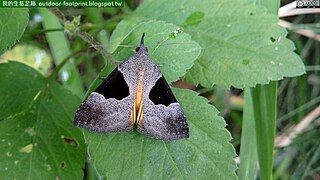
Vanessa is a genus of brush-footed butterflies in the tribe Nymphalini. It has a near-global distribution and includes conspicuous species such as the red admirals, the Kamehameha, and the painted ladies of the Cynthia group : Painted lady, American painted lady, West Coast lady, Australian painted lady, etc. For African admirals, see genus Antanartia. Recently, several members traditionally considered to be in the genus Antanartia have been determined to belong within the genus Vanessa.

Amphipyra is a genus of moths in the family Noctuidae, the only genus in the tribe Amphipyrini.

Hypena is a genus of moths in the family Erebidae. It was first described by Franz von Paula Schrank in 1802. These non-migratory moths overwinter as pupae and almost never estivate as adults.

Mocis frugalis, the sugarcane looper, is a moth of the family Erebidae. The species was first described by Johan Christian Fabricius in 1775. It is found in several parts of the world, including India, Sri Lanka, West African countries and other Oriental regions. The adult is a fruit piercer and a major pest of crops.

Grammodes geometrica is a moth found from the Mediterranean east to Oriental and Australasian tropics of India, Sri Lanka, Java and Australia. The adult is a fruit piercer. The species was first described by Johan Christian Fabricius in 1775.

Thysanoplusia orichalcea, the slender burnished brass, is a moth of the family Noctuidae. The species was first described by Johan Christian Fabricius in 1775. It is a polyphagous pest of vegetable crops that originated in Indonesia, from where it spread to Europe, South Asia, India, Sri Lanka, Africa, Australia and New Zealand. In northern Europe it is a migrant species.

Cryphia is a genus of moths of the family Noctuidae. The genus was erected by Jacob Hübner in 1818.

Dichromia is a genus of moths of the family Erebidae first described by Achille Guenée in 1854.

Mocis is a genus of moths in the family Erebidae. The genus was erected by Jacob Hübner in 1823.

Asota is a genus of moths in the family Erebidae first described by Jacob Hübner in 1819. Species are widely distributed throughout Africa, India, Sri Lanka, Myanmar, the Malayan region and tropical parts of the Australian region.

Alypia octomaculata, the eight-spotted forester, is a moth of the family Noctuidae first described by Johan Christian Fabricius in 1775. It is native to Canada, but can be found today throughout Northern America, ranging between Nova Scotia to Florida and South Dakota to Texas. Their habitats being rather specific, they make home where wooded areas meet open fields.

Achaea serva is a species of noctuid moth of the family Erebidae first described by Johan Christian Fabricius in 1775. It is found from the Indo-Australian tropics of India, Sri Lanka, Myanmar, China, Borneo, Hong Kong, Java, the Philippines, the New Hebrides, to Okinawa, many western Micronesian islands and New Guinea and Australia.

Loboschiza koenigiana, the orange tortricid moth or leaf webber, is a moth of the family Tortricidae. The species was first described by Johan Christian Fabricius in 1775. It is found in the United Arab Emirates, Pakistan, India, Sri Lanka, Myanmar, China, Malaysia, Thailand, Java in Indonesia, New Guinea, Queensland in Australia, the Philippines, Taiwan, Japan and Korea.

Polytela gloriosae, the Indian lily moth or lily caterpillar, is a moth of the family Noctuidae. The species was first described by Johan Christian Fabricius in 1781. It is found in Sri Lanka, India and probably in Indonesia.

Dichromia orosia, sometimes as Dichromia sagitta, is a moth of the family Erebidae first described by Edward Meyrick in 1913. It is found in Sri Lanka and Australia. The caterpillar is a pest of Marsdenia species, Tylophora asthntatica and Tylophora indica.















